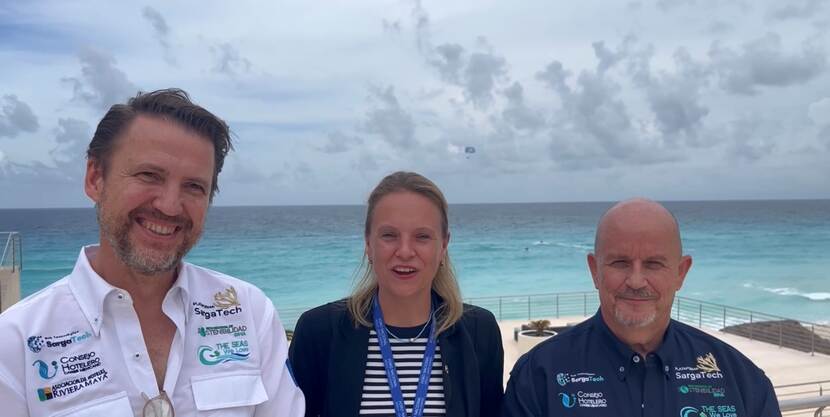Sargassum, an opportunity for Dutch-Mexican collaboration
The massive arrival of sargassum on the coasts of the Mexican Caribbean has generated an environmental and socioeconomic crisis. The excess of this seaweed has represented a loss of 11.6% of Quintana Roo’s PIB – around 41 billion Mexican pesos (~2 mld Euro). This article informs you about the opportunities for companies from the Kingdom of the Netherlands and sketches the context of sargassum in Mexico.

In response to the excess sargassum on the coasts of the Mexican Caribbean, the European Union in Mexico, the Cancun hotel initiative ‘The Seas We Love’ and the Government of Quintana Roo organized a Forum in July 2024, to identify actions and international cooperation. By aligning stakeholders, Mexico is preparing to turn sargassum into an opportunity and decreasing its current negative impacts on biodiversity. Collecting sargassum at open sea as fishery resource, is expected to become a game changer in the search for sustainable solutions for Mexico and the greater Caribbean region.
Dutch knowledge and experience key in sargassum collection and valorization?
The Kingdom of the Netherlands has a long tradition in coastal management and marine engineering. With countries in the Kingdom that are being affected by sargassum, such as Curaçao and Sint Maarten, we have developed a strong knowledge foundation. This in combination with impressive innovations for collecting plastics in open water, Mexican stakeholders consider Dutch companies and organizations key players in turning sargassum into an opportunity.
What is Mexico looking for?
Key technologies for sargassum collection:
- Vessels and open sea harvesting systems designed to collect sargassum taking into account the marine ecosystem.
- Port infrastructure for collection and storage.
- Technologies for inspection and monitoring of affected areas (water drones), satellite monitoring and modeling of the development of sargassum blooms.
Key technologies in sargassum valorization:
- Technology to turn sargassum into energy and biofuel, high-quality biofertilizers and animal feed supplements, building materials and bioactive compounds for pharmaceutical and cosmetic applications.
Together with The Seas We Love, the Dutch Embassy in Mexico has created a working group to further concretize cooperation opportunities.
Are you a company or research institute in the Kingdom of the Netherlands? And do you want to participate in this working group? Please contact us at mex-lnv@minbuza.nl
Forum results: A shift in paradigm - sargassum as a fishery resource
Although perceived as a nuisance, sargassum has the possibility to be a valuable resource and to be integrated into a circular economy framework. Its biomass can be transformed into several applications, ranging from biofuels and fertilizers to high-value products like pharmaceuticals and cosmetics. The extraction of bioactive compounds, such as alginates and fucoidans, renowned for their thickening, stabilizing and medicinal properties, underscores sargassum’s potential as a biorefinery feedstock.
At the Forum, the Mexican government and stakeholders stated it a crucial step to declare sargassum as a fishery resource, and to support its collection with regulation. Although permits haven’t been given yet, there is willingness to establish regulatory frameworks to guarantee the protection of ecosystems and to support the business case of collection. One of the leading organizations in this process is IMIPAS, the Mexican Institute for Research in Sustainable Fisheries and Aquaculture.

IMIPAS and their research vessel
IMIPAS is heading government efforts to reclassify sargassum from a nuisance to a fishery resource. A cornerstone in this initiative is a comprehensive, year-long scientific expedition in the greater Caribbean, undertaken by a Mexican research vessel. This ambitious project aims to unravel the complex dynamics of sargassum, including its origins, growth patterns, nutrient composition, and seasonal variations. By conducting meticulous sampling and analysis, IMIPAS seeks to establish a scientific foundation for sustainable sargassum management and utilization.
Through international collaboration, IMIPAS is developing standardized protocols for sargassum research, enabling data comparison and knowledge sharing among researchers worldwide. Furthermore, IMIPAS is investing in advanced modeling techniques to predict sargassum blooms, allowing for early warning systems and proactive response strategies.
The environmental and socioeconomical impact of sargassum explained
The influx of sargassum has caused a cascade of environmental and socioeconomic challenges. Its accumulation on coastlines disrupts marine ecosystems, with negative impacts on biodiversity, water quality, and sediment dynamics. Coral reefs, crucial for marine life and coastal protection, are particularly vulnerable. As sargassum decomposes, it depletes oxygen levels, releases harmful gases like hydrogen sulfide, and alters water chemistry. This leads to dying marine life and seagrass. Furthermore, the physical presence of sargassum can impede sea turtle nesting and hatching, exacerbating the decline of these endangered species.
Beyond ecological repercussions, the economic implications of sargassum are profound. The tourism industry, a cornerstone for many Caribbean economies, has suffered as beaches become inundated with decaying seaweed, deterring visitors. Fisheries have also been adversely affected, with sargassum interfering with fishing operations, damaging equipment, and reducing catch yields. Additionally, the costs associated with sargassum removal and management have placed a significant burden on the local communities and the private sector.